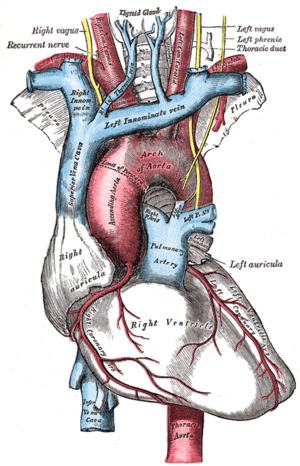Ortner's syndrome
Ortner's syndrome is a rare cardiovocal syndrome and refers to recurrent laryngeal nerve palsy from cardiovascular disease.[1] It was first described by Norbert Ortner (1865–1935), an Austrian physician, in 1897.
| Ortner's syndrome | |
|---|---|
 | |
| Image of aortic anatomy showing proximity of vagus nerve and its recurrent branch to the aorta | |
| Specialty | Neurology |
The most common historical cause is a dilated left atrium due to mitral stenosis, but other causes, including pulmonary hypertension,[2] thoracic aortic aneurysms, an enlarged pulmonary artery[3] and aberrant subclavian artery syndrome have been reported compressing the nerve.[4]
Dysphagia caused by a similar mechanism is referred to as dysphagia aortica, or, in the case of subclavian artery aberrancy, as dysphagia lusoria. Due to compression of recurrent laryngeal nerve it can cause the hoarseness of the voice which is also one of the sign of the mitral stenosis. A second Ortner's syndrome, Ortner's syndrome II, refers to abdominal angina.
References
- Bickle IC, Kelly BE, Brooker DS (May 2002). "Ortner's syndrome: a radiological diagnosis". Ulster Med J. 71 (1): 55–6. PMC 2475354. PMID 12137166.
- Hermans C, Manocha S, McLaughlin JE, Lipman M, Lee CA (September 2005). "Ortner syndrome and haemophilia". Haemophilia. 11 (5): 548–51. doi:10.1111/j.1365-2516.2005.01140.x. PMID 16128901.
- Armstrong, Guy. "Mitral Stenosis". Merck Manual. Merck Manual. Retrieved 2015-04-19.
- Escribano JF, Carnés J, Crespo MA, Antón RF (2006). "Ortner's syndrome and endoluminal treatment of a thoracic aortic aneurysm: a case report". Vasc Endovascular Surg. 40 (1): 75–8. doi:10.1177/153857440604000111. PMID 16456610.